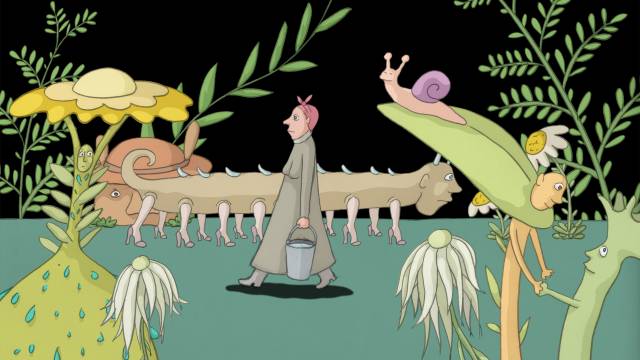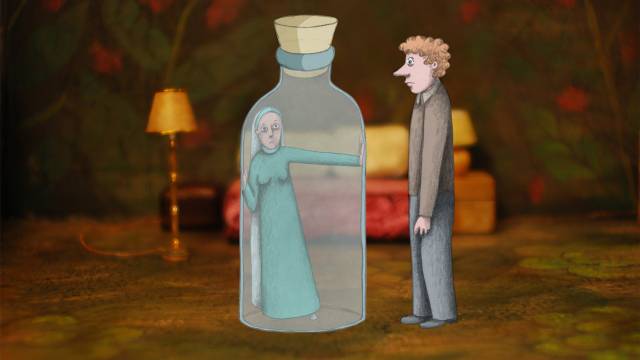
 I met Signe Baumane in a crowded midtown cafe to discuss her new film Rocks in My Pockets; she broke the ice by telling me something very interesting about my surname, “in Latvian it means steps”, she said with a bright smile. I told her I had no idea and she explained “there are only so many sounds humans can make, we end up repeating the same sounds”. Her new film is a strange, dazzling account of what it was like to be raised in a family ruled by depression and the fact that we were meeting the day after Robin Williams’ untimely death, after a battle with depression, made me fear that our conversation would become too morbid or bleak. Instead, I was surprised by Baumane’s hands-on approach to the topic, after confessing she was heartbroken about the news, mostly because she had felt identified with the late actor’s struggles (“I wonder what made him think he wouldn’t be able to pull through this time”) she smartly discussed how she brought her own demons to the making of her film.
I met Signe Baumane in a crowded midtown cafe to discuss her new film Rocks in My Pockets; she broke the ice by telling me something very interesting about my surname, “in Latvian it means steps”, she said with a bright smile. I told her I had no idea and she explained “there are only so many sounds humans can make, we end up repeating the same sounds”. Her new film is a strange, dazzling account of what it was like to be raised in a family ruled by depression and the fact that we were meeting the day after Robin Williams’ untimely death, after a battle with depression, made me fear that our conversation would become too morbid or bleak. Instead, I was surprised by Baumane’s hands-on approach to the topic, after confessing she was heartbroken about the news, mostly because she had felt identified with the late actor’s struggles (“I wonder what made him think he wouldn’t be able to pull through this time”) she smartly discussed how she brought her own demons to the making of her film.
Through hypnotic animation, Rocks in My Pockets tells the story of several generations of Latvian women who must deal with depression, all of this leading Baumane to wonder if she might in fact have inherited this from her ancestors. Providing a crash course through Eastern European history, while serving as a fascinating character study, Rocks in My Pockets is the rare kind of film that feels deeply personal and universal at the same time.
When did you realize that you wanted to tell this through an animated movie? As opposed to a book or a play?
I’m an animator, I became an animator by accident, but for me animation is my medium, my voice, how I think. A bird flies, a deer runs, I think through animation...I believe animation is the best way to express metaphors, and for example the other well known film about mental illness was Silver Linings Playbook, and when you think about the difference between that movie and mine, you realize you tell the stories in a very different way through animation. I felt animation was a perfect way to tell my story cause it uses symbols, visual metaphors...at the same time my narration explains what you see and quite don’t understand. The voiceover and the visuals are parallel and compliment each other, I’m prone to crazy images and people sometimes don’t know what they’re looking at. I have a tendency to do that, for me it’s clear but when people look at it, it’s too far out there.
What’s your writing process like? Do you see these images and then write, or do you write first and describe what the animation will be like?
It’s a very good question because I always ponder how other people do it. You see movies and wonder how people could conceive the images. As a creator sometimes I can’t decipher how to create images. Animation usually starts with a soundtrack cause it’s easy to set images to sounds, then usually we do storyboards which are a rule. Animation is expensive so storyboards help us waste as little as possible, but about ten years ago I decided I wouldn’t use storyboards, they make me feel like I’m a prisoner, like there’s no creativity. Every time I sit down to work with a storyboard I want to cry. I like the creative suspense and I like to leave that in my process. So I decided to write the script and then worked with the co-producer on the draft.
From Bill Plympton to Jan Svankmajer, you seem to be carrying your references with you and not afraid of showing them. What were some other animators whose work you admired?
None cause I didn’t study animation. I come from a writing background, when I was 8 I wanted to be a writer, I felt writers had the ability to enter my mind so I wanted to write books to enter other people’s minds. In Eastern Europe there is a very rich tradition of illustration and poster art, growing up I remember very subversive posters that made you look twice and often bypassed officials. My other influence is philosophy.
Did you ever become so frustrated with the project you decided you wanted to quit?
(Laughs) No, I’m not that kind of person, I’m like a pitbull, if I grab a leg I won’t let it go!
You made the papier mache backgrounds and animated the whole movie yourself…
It was crazy. In some ways I’m immensely grateful that I’m able to do so many things on my own: to write, animate, do the colors, tridimensional objects and even now I have to do marketing...I don’t need a huge crew, I had a small team, but on the other hand this can also be a trap cause since I don’t need a studio I fall through the cracks of this commercial world.

How did you come up with the idea of combining these two methods, the 2D animation and papier mache?
In 2007 I hooked up with this Italian designer called Aspesi, who doesn’t sell his stuff in the USA, he’s a fun character, so my friends in Milan connected me with him and he liked my work. He asked if I’d come and paint a mural, I’d never painted a mural before but he offered ten thousand dollars and of course I’d do anything for that amount of money (laughs). I said “sure” and painted for two nerve-wracking weeks. I finished it and he was very happy, so he asked me to do sculptures, he asked if I could do human size papier mache sculptures, I said sure and for two years I’d go to Milan and did these sculptures. I’m not a trained sculpture but papier mache is magical! When I decided to make this film the images in my mind were in this technique and I wanted to incorporate 3D objects in my film. Since they were not bendable, I decided to make them backgrounds.
Depression is a very delicate subject matter, because people can be quite judgmental about it. Were you afraid of being so personal in your film?
I don’t know, I wasn’t thinking. It’s only know that I wonder if this was the right thing to do (laughs). It’s now very hard for me to separate the film from me, whenever something bad happens to you and you tell it in a story, it’s about telling the story and trying to keep your audience entertained. The film is strange, a thing on its own and some people had a hard time accepting it. Now we’re premiering the film in Latvia and I’m worried cause all my relatives are coming! When they found out I was making a film back in 2010 they said I shouldn’t do it, and they couldn’t stop me, but now they’ll see it and it’s a film about them!
But it’s also a beautiful way for you to pay tribute to them and their legacy…
If I wanted to preserve my family history I would’ve concentrated on another character, but I chose to make the film about depression, but you’re right, it’s a tribute to my family, about my grandmother...so you’re right, they should be happy (laughs)
Did you discover anything about yourself while making the film?
Maybe in the process. Making a feature is like a marathon and I had only trained to run sprints. Sometimes you’re making something in complete darkness and you don’t know how people will react.
Were there things you wanted to do in this film that you decided to save for the future instead?
Yeah, I wanna use 3D backgrounds again but make them very crazy and surreal...but I have to write the script for that first.
This is not the first time you’ve touched on a potentially controversial topic. In Teat Beat of Sex you explored female sexuality in a very explicit way and I thought it was quite interesting to see how much you focus on the body. From body functions to exploring body parts. Can you elaborate on why it’s such an important part of your art?
I don’t know, it’s just one of the things that interests me as an artist. If you think about it we feel our bodies all day long but then we deny it. For example, we’re sitting on our butts but we deny that because we make the conversation more important, so I want to see what happens with these things we don’t talk about. We are told by commercials and pornography that there are specific things that are sexy, but what we are taught is sexy is in reality counterproductive...like pubic hair or having a big penis, and the reality is different, so I wanted to make fun of that.
 Your work teaches us lessons about sex and history, but it’s not exclusively didactic. How did you achieve this balance?
Your work teaches us lessons about sex and history, but it’s not exclusively didactic. How did you achieve this balance?
I want to entertain, engage and provoke. I want to enter your mind but I don’t want to stay in there, I just want to go there for a while and to shake it. My work is also very polarizing, but in reality I’m a nice person and I want to be liked by everyone. I make films to be liked and people always either love them or hate them. I guess I have to accept this…(laughs)
Do you think of your work as feminist?
That’s a very complex, very political question. I personally have never felt abused by men and never thought about this much, when I started in animation people would point out that I’d have it hard working in a male-centric world, but I actually thought it would be a benefit, cause people would expect so little from me that I’d be able to surprise them. As the time progressed and I got older, I saw these men who started out with me who now are big shots, they have agents, commercial jobs and I have none of this. In 2007 a TV company approached me asking me to make animation for them and I thought “finally”! They asked me to make animated pieces for them and I tried giving them what they asked, but they wanted me to make my female characters with bigger boobs and bigger asses. But I was the wrong person for that, it wouldn’t have been me, so they tried to fit me in their show and they couldn’t, so they hired a man to do something for them. So I realized there was a certain kind of sexism, because I couldn’t adjust to the demographics they wanted to please, which were young males, because I was a woman. If you want to call me a feminist, I am. I believe in equality, because women are just as talented as men, but there is also something in our nature that makes us more nurturing, which is why we see many women producers, because we don’t have the same ego as men. Women will often put aside their creative projects to nurture a man’s project. We are trained to be team players...so when I see girls going into producing I feel that they’re sometimes falling into traps because they are putting their directorial projects to the side.
In the film you say your family was opposed to you becoming an artist, have they become more accepting?
It’s complicated (laughs). My mom definitely went through this phase because no one in my direct family wanted me to make art. They first thought animation was for children, but there was a point when I was making sex illustrations that were being published in a Latvian art magazine and when I visited my mom she gave them to me and said “I don’t want this filth in my house”. You know, you have to be who you are and try not to be expelled from your family in the process. I was also writing a novel in a Latvian magazine and my mom refused to read it, but then people in the town where she lives started telling her how good the writing was and how they saw themselves reflected in my work. So my mom said “maybe it’s not so bad if other people are talking about it”.
Rocks in My Pockets is now in theaters.